Use of New Green Bitumen Modifier for Asphalt Mixtures Recycling
Abstract
1. Introduction
2. Materials and Methods
2.1. Materials
2.2. Sodium Alginate- and Sodium Alginate/Epichlorohydrin Mixture-Modified Bitumen Preparation
2.3. Asphalt Mix Design
2.4. Test Methods
3. Results and Discussion
3.1. Determination of Optimal Biopolymer Dosage
3.2. Biopolymer-Modified Bitumennanostructure Analysis
3.2.1. Fourier-Transform Infrared Spectroscopy
3.2.2. Atomic Force Microscopy
3.3. Asphalt Mixtures Properties
3.3.1. Volumetric Parameters
3.3.2. Stiffness Modulus
3.3.3. Water and Frost Resistance
4. Conclusions
- The sodium alginate modification of bitumen without crosslinking agent caused binder hardening through the formation of higher bee structures formed as a result of the formation of asphaltene aggregations.
- With the addition of 1% epichlorohydrin as a crosslinking agent, the binder softening effect was achieved. It is hypothesised that crosslinking of the biopolymer molecules takes place in the binder volume, resulting in the formation of structures with higher molecular weight. These structures can be incorporated between plane asphaltenes, limiting their aggregation and as a consequence reducing binder hardening. Secondly, the softening effect may also occur due to chemical reactions of sodium alginate -OH groups with oxygen atoms present in the structures of aged bitumen components.
- The observed decrease in viscosity of the binder modified with crosslinking agent provides appropriate aggregate coating during the asphalt mixture production process.
- The asphalt mix containing RAP with biopolymer-modified binder was characterised by better workability and compactibility, which had a direct impact on its volumetric properties, especially air void content.
- The stiffness modulus of the asphalt mix containing RAP and biopolymer-modified binder showed similar behaviour to the mixture with PMB rejuvenated by WEO at high temperature, whereas at low temperature, its behaviour was similar to the asphalt mix with PMB binder.
- A key finding of presented research was the enhancement of water and frost resistance (defined by ITSR indicator) in the asphalt mix with the biopolymer-modified bitumen.
Author Contributions
Funding
Institutional Review Board Statement
Informed Consent Statement
Data Availability Statement
Conflicts of Interest
References
- Woszuk, A. Application of fly ash derived zeolites in warm-mix asphalt technology. Material 2018, 11, 1542. [Google Scholar] [CrossRef] [PubMed]
- Woszuk, A.; Wróbel, M.; Bandura, L.; Franus, W. Brick Debris Dust as an Ecological Filler and Its Effect on the Durability of Asphalt Mix. Materials 2020, 13, 5023. [Google Scholar] [CrossRef] [PubMed]
- Andrzejuk, W.; Barnat-Hunek, D.; Siddique, R.; Zegardlo, B.; Lagód, G. Application of recycled ceramic aggregates for the production of Mineral-Asphalt Mixtures. Materials 2018, 11, 658. [Google Scholar] [CrossRef]
- Foroutan Mirhosseini, A.; Tahami, S.A.; Hoff, I.; Dessouky, S.; Ho, C.H. Performance evaluation of asphalt mixtures containing high-RAP binder content and bio-oil rejuvenator. Constr. Build. Mater. 2019, 227, 116465. [Google Scholar] [CrossRef]
- Zaumanis, M.; Arraigada, M.; Wyss, S.A.; Zeyer, K.; Cavalli, M.C.; Poulikakos, L.D. Performance-based design of 100% recycled hot-mix asphalt and validation using traffic load simulator. J. Clean. Prod. 2019, 237, 117679. [Google Scholar] [CrossRef]
- Zhang, J.; Sun, C.; Li, P.; Jiang, H.; Liang, M.; Yao, Z.; Zhang, X.; Airey, G. Effect of different viscous rejuvenators on chemical and mechanical behavior of aged and recovered bitumen from RAP. Constr. Build. Mater. 2020, 239, 117755. [Google Scholar] [CrossRef]
- Zaumanis, M.; Mallick, R.; Frank, R. Evaluation of rejuvenator’s effectiveness with conventional mix testing for 100% reclaimed Asphalt pavement mixtures. Transp. Res. Rec. 2013, 2370, 17–25. [Google Scholar] [CrossRef]
- Silva, H.M.R.D.; Oliveira, J.R.M.; Jesus, C.M.G. Are totally recycled hot mix asphalts a sustainable alternative for road paving? Resour. Conserv. Recycl. 2012, 60, 38–48. [Google Scholar] [CrossRef]
- Daryaee, D.; Ameri, M.; Mansourkhaki, A. Utilizing of waste polymer modified bitumen in combination with rejuvenator in high reclaimed asphalt pavement mixtures. Constr. Build. Mater. 2020, 235, 117516. [Google Scholar] [CrossRef]
- Ren, S.; Liu, X.; Wang, H.; Fan, W.; Erkens, S. Evaluation of rheological behaviors and anti-aging properties of recycled asphalts using low-viscosity asphalt and polymers. J. Clean. Prod. 2020, 253, 120048. [Google Scholar] [CrossRef]
- Li, J.; Ni, F.; Huang, Y.; Gao, L. New additive for use in hot in-place recycling to improve performance of reclaimed asphalt pavement mix. Transp. Res. Rec. 2014, 2445, 39–46. [Google Scholar] [CrossRef]
- Wróbel, M.; Woszuk, A.; Franus, W. Laboratory Methods for Assessing the Influence of Improper Asphalt Mix Compaction on Its Performance. Materials 2020, 13, 2476. [Google Scholar] [CrossRef] [PubMed]
- Norgbey, E.; Huang, J.; Hirsch, V.; Liu, W.J.; Wang, M.; Ripke, O.; Li, Y.; Takyi Annan, G.E.; Ewusi-Mensah, D.; Wang, X.; et al. Unravelling the efficient use of waste lignin as a bitumen modifier for sustainable roads. Constr. Build. Mater. 2020, 230, 116957. [Google Scholar] [CrossRef]
- Chang, I.; Im, J.; Cho, G.C. Introduction of microbial biopolymers in soil treatment for future environmentally-friendly and sustainable geotechnical engineering. Sustainability 2016, 8, 251. [Google Scholar] [CrossRef]
- Hataf, N.; Ghadir, P.; Ranjbar, N. Investigation of soil stabilization using chitosan biopolymer. J. Clean. Prod. 2018, 170, 1493–1500. [Google Scholar] [CrossRef]
- Pérez, I.P.; Rodríguez Pasandín, A.M.; Pais, J.C.; Alves Pereira, P.A. Use of lignin biopolymer from industrial waste as bitumen extender for asphalt mixtures. J. Clean. Prod. 2019, 220, 87–98. [Google Scholar] [CrossRef]
- Yuanita, E.; Hendrasetyawan, B.E.; Firdaus, D.F.; Chalid, M. Improvement of polypropylene (PP)-modified bitumen through lignin addition. IOP Conf. Ser. Mater. Sci. Eng. 2017, 223, 012028. [Google Scholar] [CrossRef]
- Vale, A.C.D.; Casagrande, M.D.T.; Soares, J.B. A Study of Behavior Of Natural Fiber In Stone Matrix Asphalt Mixtures Using Two Design Methods. J. Mater. Civ. Eng. 2014, 26, 457–465. [Google Scholar] [CrossRef]
- Desseaux, S.; dos Santos, S.; Geiger, T.; Tingaut, P.; Zimmermann, T.; Partl, M.N.; Poulikakos, L.D. Improved mechanical properties of bitumen modified with acetylated cellulose fibers. Compos. Part B Eng. 2018, 140, 139–144. [Google Scholar] [CrossRef]
- Eskandarsefat, S.; Hofko, B.; Rossi, C.O.; Sangiorgi, C. Fundamental properties of bitumen binders containing novel cellulose-based poly-functional fibres. Compos. Part B Eng. 2019, 163, 339–350. [Google Scholar] [CrossRef]
- Fernando, I.P.S.; Lee, W.W.; Han, E.J.; Ahn, G. Alginate-based nanomaterials: Fabrication techniques, properties, and applications. Chem. Eng. J. 2020, 391, 123823. [Google Scholar] [CrossRef]
- Jiang, J.; Chen, Y.; Wang, W.; Cui, B.; Wan, N. Synthesis of superparamagnetic carboxymethyl chitosan/sodium alginate nanosphere and its application for immobilizing α-amylase. Carbohydr. Polym. 2016, 151, 600–605. [Google Scholar] [CrossRef] [PubMed]
- Lee, K.Y.; Mooney, D.J. Alginate: Properties and biomedical applications. Prog. Polym. Sci. 2012, 37, 106–126. [Google Scholar] [CrossRef] [PubMed]
- Xu, S.; Liu, X.; Tabaković, A.; Lin, P.; Zhang, Y.; Nahar, S.; Lommerts, B.J.; Schlangen, E. The role of rejuvenators in embedded damage healing for asphalt pavement. Mater. Des. 2021, 202, 109564. [Google Scholar] [CrossRef]
- Tabaković, A.; Braak, D.; van Gerwen, M.; Copuroglu, O.; Post, W.; Garcia, S.J.; Schlangen, E. The compartmented alginate fibres optimisation for bitumen rejuvenator encapsulation. J. Traffic Transp. Eng. 2017, 4, 347–359. [Google Scholar] [CrossRef]
- Xu, S.; Liu, X.; Tabaković, A.; Schlangen, E. Investigation of the potential use of calcium alginate capsules for self-healing in porous asphalt concrete. Materials 2019, 12, 168. [Google Scholar] [CrossRef]
- Xu, S.; Tabaković, A.; Liu, X.; Schlangen, E. Calcium alginate capsules encapsulating rejuvenator as healing system for asphalt mastic. Constr. Build. Mater. 2018, 169, 379–387. [Google Scholar] [CrossRef]
- AASHTO T 283; Standard Method of Test for Resistance of Compacted Asphalt Mixtures to Moisture-Induced Damage. American Association of State Highway and Transportation Officials: Washington, DC, USA, 2018.
- Wróbel, M.; Woszuk, A.; Ratajczak, M.; Franus, W. Properties of reclaimed asphalt pavement mixture with organic rejuvenator. Constr. Build. Mater. 2021, 271, 121514. [Google Scholar] [CrossRef]
- Woszuk, A.; Wróbel, M.; Franus, W. Influence of waste engine oil addition on the properties of zeolite-foamed asphalt. Materials 2019, 12, 2265. [Google Scholar] [CrossRef]
- Woszuk, A.; Franus, W. A review of the application of zeolite materials in warm mix asphalt technologies. Appl. Sci. 2017, 7, 1–15. [Google Scholar] [CrossRef]
- Yao, H.; You, Z.; Li, L.; Goh, S.W.; Lee, C.H.; Yap, Y.K.; Shi, X. Rheological properties and chemical analysis of nanoclay and carbon microfiber modified asphalt with Fourier transform infrared spectroscopy. Constr. Build. Mater. 2013, 38, 327–337. [Google Scholar] [CrossRef]
- Lamontagne, J.; Durrieu, F.; Planche, J.P.; Mouillet, V.; Kister, J. Direct and continuous methodological approach to study the ageing of fossil organic material by infrared microspectrometry imaging: Application to polymer modified bitumen. Anal. Chim. Acta 2001, 444, 241–250. [Google Scholar] [CrossRef]
- Mouillet, V.; Lamontagne, J.; Durrieu, F.; Planche, J.P.; Lapalu, L. Infrared microscopy investigation of oxidation and phase evolution in bitumen modified with polymers. Fuel 2008, 87, 1270–1280. [Google Scholar] [CrossRef]
- Mouazen, M.; Poulesquen, A.; Vergnes, B. Influence of thermomechanical history on chemical and rheological behavior of bitumen. Energy Fuels 2011, 25, 4614–4621. [Google Scholar] [CrossRef]
- Pereira, R.; Tojeira, A.; Vaz, D.C.; Mendes, A.; Bártolo, P. Preparation and characterization of films based on alginate and aloe vera. Int. J. Polym. Anal. Charact. 2011, 16, 449–464. [Google Scholar] [CrossRef]
- Sciamareli, J.; Cassu, S.N.; Iha, K. Water influence in poly(epichlorohydrin) synthesis: An intermediate to energetic propellants. J. Aerosp. Technol. Manag. 2012, 4, 41–44. [Google Scholar] [CrossRef][Green Version]
- Zhang, H.; Wang, Y.; Yu, T.; Liu, Z. Microstructural characteristics of differently aged asphalt samples based on atomic force microscopy (AFM). Constr. Build. Mater. 2020, 255, 119388. [Google Scholar] [CrossRef]
- Wang, Y.; Zhao, K.; Li, F.; Gao, Q.; Lai, K.W.C. Asphaltenes in asphalt: Direct observation and evaluation of their impacts on asphalt properties. Constr. Build. Mater. 2021, 271, 121862. [Google Scholar] [CrossRef]
- Lyne, Å.L.; Wallqvist, V.; Birgisson, B. Adhesive surface characteristics of bitumen binders investigated by Atomic Force Microscopy. Fuel 2013, 113, 248–256. [Google Scholar] [CrossRef]
- Cai, X.; Zhang, J.; Xu, G.; Gong, M.; Chen, X.; Yang, J. Internal aging indexes to characterize the aging behavior of two bio-rejuvenated asphalts. J. Clean. Prod. 2019, 220, 1231–1238. [Google Scholar] [CrossRef]
- Cao, X.; Wang, H.; Cao, X.; Sun, W.; Zhu, H.; Tang, B. Investigation of rheological and chemical properties asphalt binder rejuvenated with waste vegetable oil. Constr. Build. Mater. 2018, 180, 455–463. [Google Scholar] [CrossRef]
- Ingrassia, L.P.; Lu, X.; Ferrotti, G.; Canestrari, F. Renewable materials in bituminous binders and mixtures: Speculative pretext or reliable opportunity? Resour. Conserv. Recycl. 2019, 144, 209–222. [Google Scholar] [CrossRef]
- Bernier, A.; Zofka, A.; Josen, R.; Mahoney, J. Warm-mix asphalt pilot project in Connecticut. Transp. Res. Rec. 2012, 2294, 106–116. [Google Scholar] [CrossRef]
- Vacková, P.; Valentin, J.; Kotoušová, A. Impact of lowered laboratory compaction rate on strength properties of asphalt mixtures. Innov. Infrastruct. Solut. 2018, 3, 1–8. [Google Scholar] [CrossRef]
- Liu, S.; Peng, A.; Wu, J.; Zhou, S.B. Waste engine oil influences on chemical and rheological properties of different asphalt binders. Constr. Build. Mater. 2018, 191, 1210–1220. [Google Scholar] [CrossRef]
- Abdullah, M.E.; Kamaruddin, N.H.M.; Daniel, B.D.; Hassan, N.A.; Hainin, M.R.; Tajudin, S.A.A.; Madun, A.; Mapanggi, R. Stiffness modulus properties of hot mix asphalt containing waste engine oil. ARPN J. Eng. Appl. Sci. 2016, 11, 14089–14091. [Google Scholar]
- Halle, M.; Rukavina, T.; Domitrovic, J. Influence of temperature on asphalt stiffness modulus. In Proceedings of the 5th Eurasphalt Eurobitume Congress, Istanbul, Turkey, 13–15 June 2012; pp. 13–15. [Google Scholar]
- Ahmed, K.; Irfan, M.; Ahmed, S.; Khattak, A.A.A. Experimental investigation of strength and stiffness characteristics of hot mix asphalt (HMA). Procedia Eng. 2014, 77, 155–160. [Google Scholar] [CrossRef][Green Version]
- Zaumanis, M.; Mallick, R.B.; Poulikakos, L.; Frank, R. Influence of six rejuvenators on the performance properties of Reclaimed Asphalt Pavement (RAP) binder and 100% recycled asphalt mixtures. Comput. Chem. Eng. 2014, 71, 538–550. [Google Scholar] [CrossRef]
- Behnood, A. Application of rejuvenators to improve the rheological and mechanical properties of asphalt binders and mixtures: A review. J. Clean. Prod. 2019, 231, 171–182. [Google Scholar] [CrossRef]
- Kuang, D.; Liu, W.; Xiao, Y.; Wan, M.; Yang, L.; Chen, H. Study on the rejuvenating mechanism in aged asphalt binder with mono-component modified rejuvenators. Constr. Build. Mater. 2019, 223, 986–993. [Google Scholar] [CrossRef]
- Mamun, A.A.; Al-Abdul Wahhab, H.I. Evaluation of Waste Engine Oil-Rejuvenated Asphalt Concrete Mixtures with High RAP Content. Adv. Mater. Sci. Eng. 2018, 2018, 7386256. [Google Scholar] [CrossRef]
- Suresh, M.; Pal, M. Effect of centrifuged latex on moisture damage of hot-mix asphalt with brick aggregate. Proc. Inst. Civ. Eng. Transp. 2021, 174, 99–109. [Google Scholar] [CrossRef]
- Pasandín, A.R.; Galán-Díaz, J.J.; Pérez, I. Adhesion analysis of waste cork dust as filler for bituminous mixtures. In Wastes: Solutions, Treatments and Opportunities; CRC Press: Boca Raton, FL, USA, 2019; pp. 1–6. [Google Scholar] [CrossRef]
- Peng, C.; Huang, S.; You, Z.; Xu, F.; You, L.; Ouyang, H.; Li, T.; Guo, C.; Ma, H.; Chen, P.; et al. Effect of a lignin-based polyurethane on adhesion properties of asphalt binder during UV aging process. Constr. Build. Mater. 2020, 247, 118547. [Google Scholar] [CrossRef]
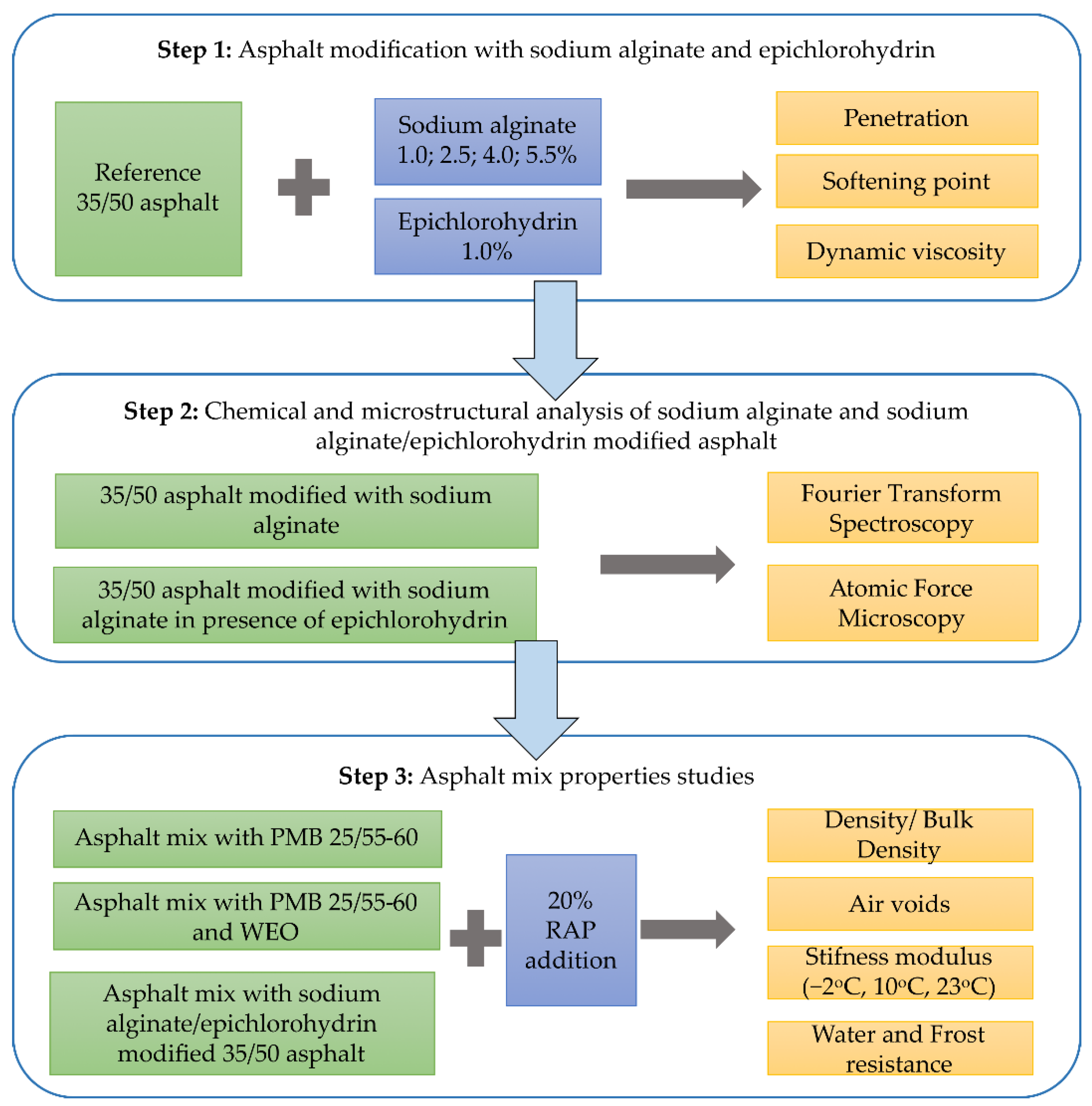
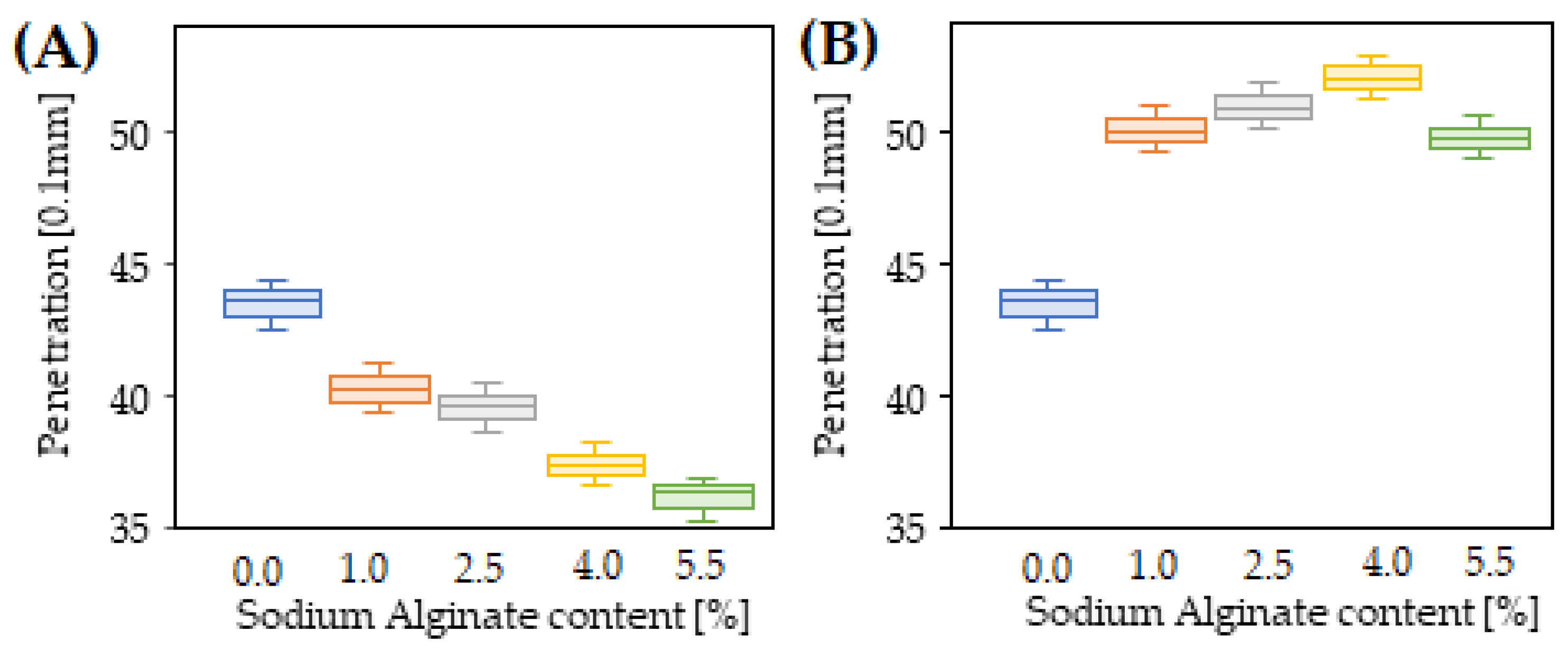
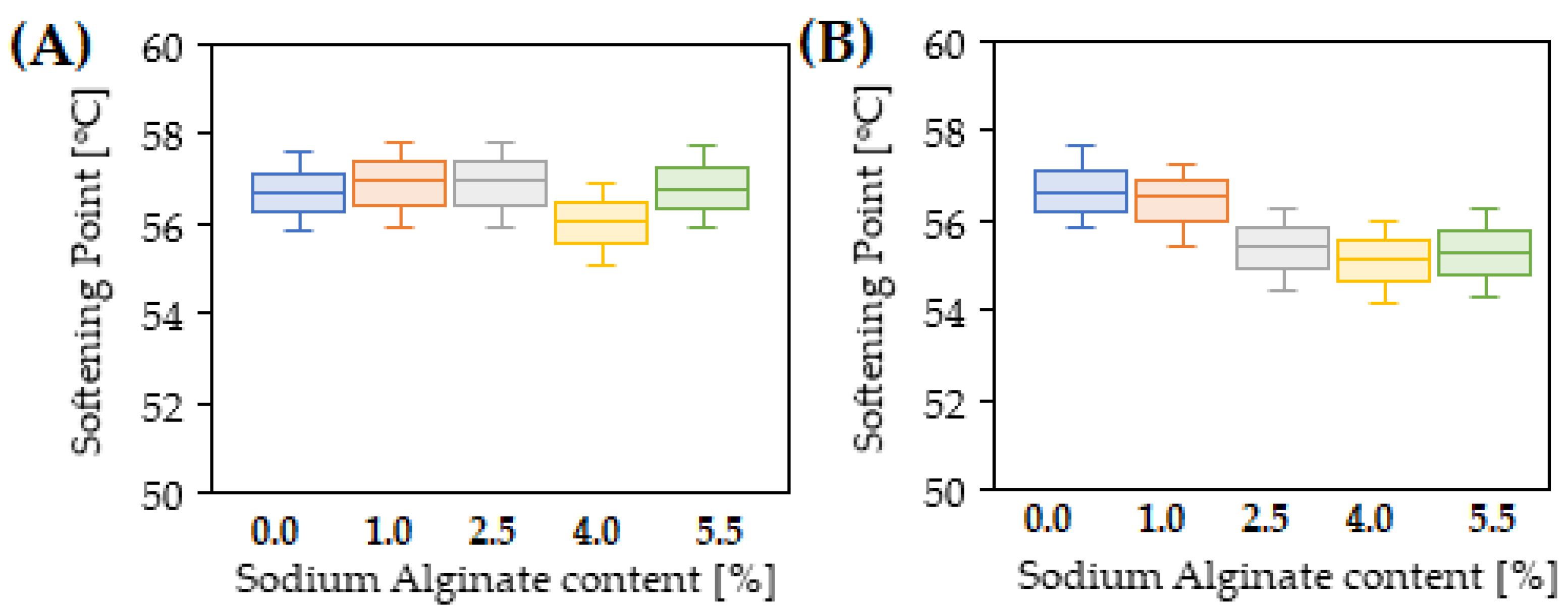

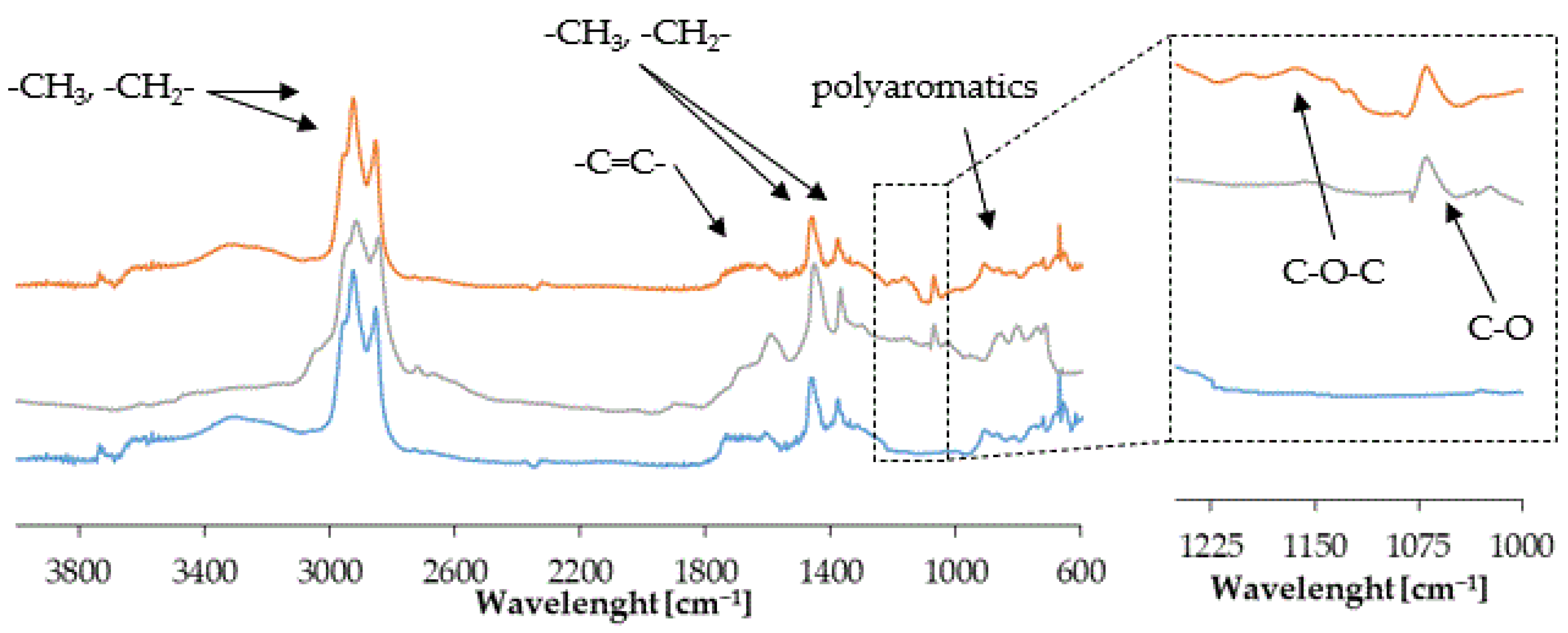
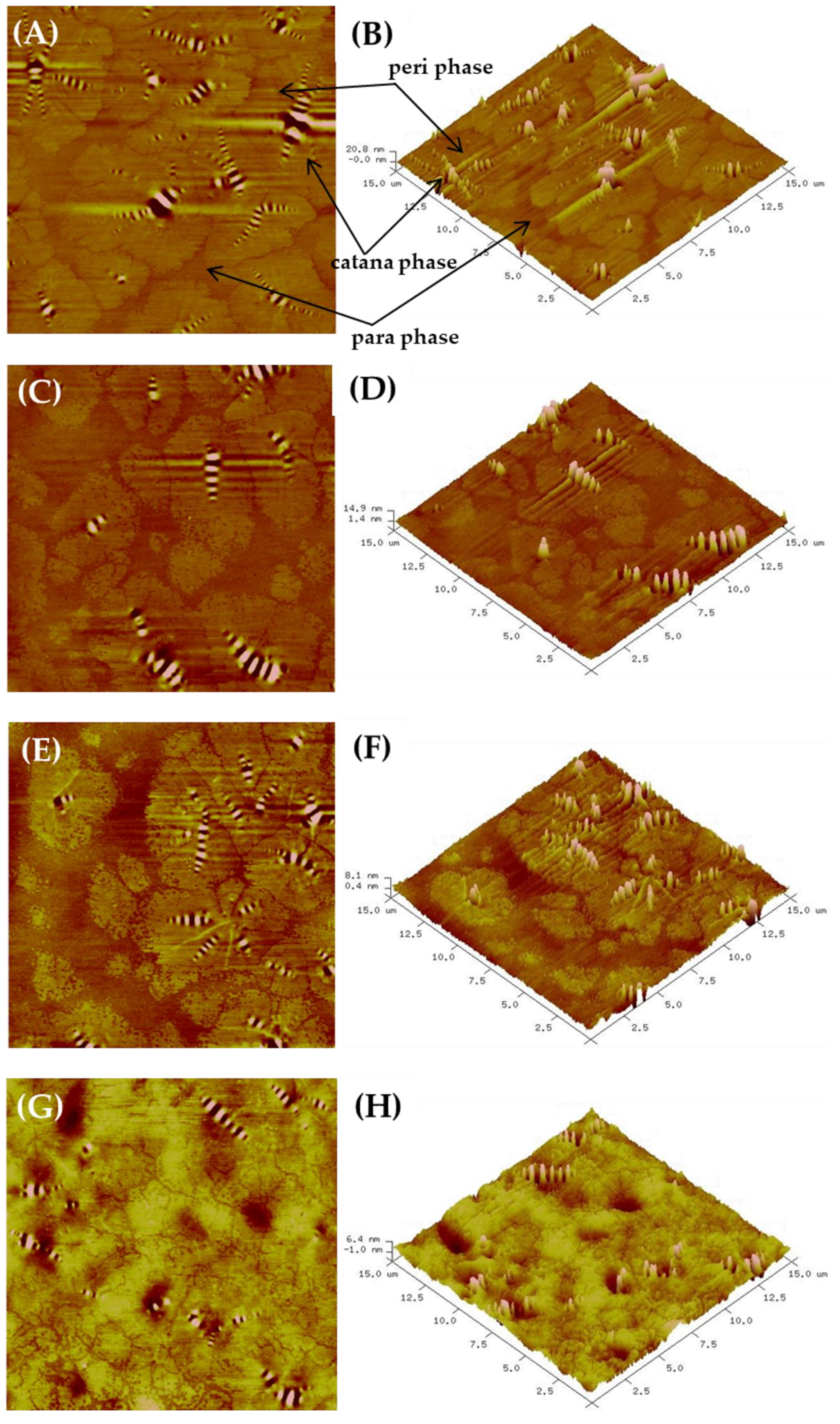

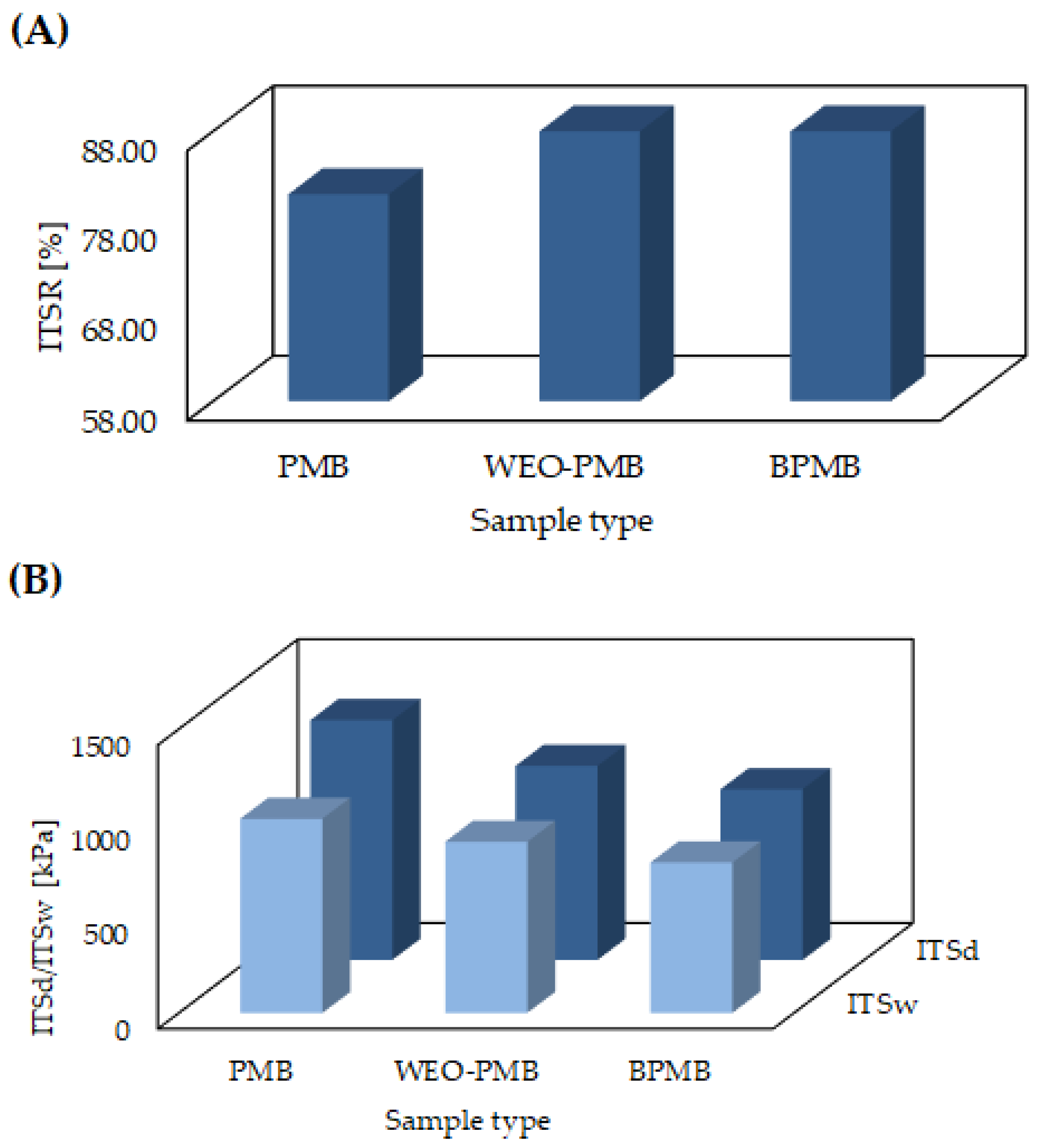
| Penetration [0.1 mm] | Softening Point [°C] | Dynamic Viscosity [mPa·s] (T = 160 °C) | |
|---|---|---|---|
| 35/50 | 43.5 | 56.4 | 210.0 |
| PMB 25/55-60 | 38.0 | 68.0 | 594.0 |
| Material | Percentage (% of Mass) | |
|---|---|---|
| Mineral Mix | Asphalt Mix | |
| Mineral filler | 1.0 | 1.0 |
| 0/2 Dolomite | 17.0 | 16.2 |
| 2/8 Dolomite | 25.0 | 23.9 |
| 8/11 Dolomite | 17.0 | 16.2 |
| 8/16 Dolomite | 20.0 | 19.1 |
| RAP | 20.0 | 19.1 |
| Bitumen | - | 3.3 |
| Sample | Stiffness Modulus [MPa] at 23 °C | Stiffness Modulus [MPa] at 10 °C | Stiffness Modulus [MPa] at −2 °C |
|---|---|---|---|
| PMB | 6249 | 11,518 | 19,743 |
| WEO-PMB | 5213 | 9777 | 18,273 |
| BPMB | 5191 | 10,346 | 19,743 |
Publisher’s Note: MDPI stays neutral with regard to jurisdictional claims in published maps and institutional affiliations. |
© 2022 by the authors. Licensee MDPI, Basel, Switzerland. This article is an open access article distributed under the terms and conditions of the Creative Commons Attribution (CC BY) license (https://creativecommons.org/licenses/by/4.0/).
Share and Cite
Malinowski, S.; Wróbel, M.; Bandura, L.; Woszuk, A.; Franus, W. Use of New Green Bitumen Modifier for Asphalt Mixtures Recycling. Materials 2022, 15, 6070. https://doi.org/10.3390/ma15176070
Malinowski S, Wróbel M, Bandura L, Woszuk A, Franus W. Use of New Green Bitumen Modifier for Asphalt Mixtures Recycling. Materials. 2022; 15(17):6070. https://doi.org/10.3390/ma15176070
Chicago/Turabian StyleMalinowski, Szymon, Michał Wróbel, Lidia Bandura, Agnieszka Woszuk, and Wojciech Franus. 2022. "Use of New Green Bitumen Modifier for Asphalt Mixtures Recycling" Materials 15, no. 17: 6070. https://doi.org/10.3390/ma15176070
APA StyleMalinowski, S., Wróbel, M., Bandura, L., Woszuk, A., & Franus, W. (2022). Use of New Green Bitumen Modifier for Asphalt Mixtures Recycling. Materials, 15(17), 6070. https://doi.org/10.3390/ma15176070










